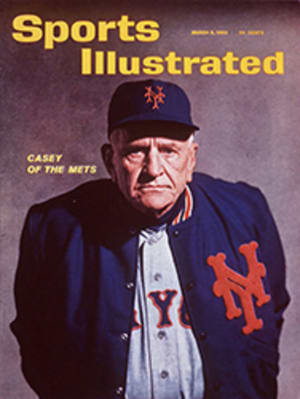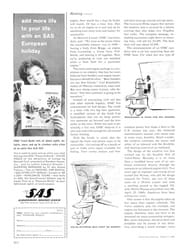
A Lot of Good Things in One Slick Package
The thousands who jam Chicago's McCormick Place for the annual March Boat Show (March 2-11) come for a first look at the exciting new products that will set the trends in the boating season ahead. This year the most important thing they will see is the sleek plastic runabout above.
Fresh from the drawing boards of the Outboard Marine Corporation, the world's largest outboard manufacturers, the 17-footer is not yet in full production; but the prototype shown here may well make the biggest splash in boating since the outboard itself—for two very good reasons. One is that the OMC boat does not use a conventional outboard but rather an inboard-outboard—or outdrive—engine, the newest and most promising of marine power units. The other reason is that both the exterior power unit and the boat are made as a package by OMC. The McCulloch Corporation, makers of Scott outboards, started this trend to the boat-and-engine package last year when they produced a 17-foot runabout to go with their 75-hp outboard. This rig, the first ever produced by an outboard motor manufacturer, proved so successful that Scott has stepped up its 1962 boat production to nine different models. With this plunge into boatbuilding by Scott—and now Outboard Marine—the day has finally arrived when the outboard customer no longer has to buy a separate engine, then search for a boat he hopes will match. Or buy a boat first, then try to fit an engine to it and end up by spending even more time and money for accessories.
As Howard Larson, OMC vice-president, said, "We were at the point where the automobile industry was in 1920—buying a body from Briggs, an engine from Lycoming, a frame from A.O. Smith, and putting it all together. Now we're preparing to turn out matched units—a boat built for a particular engine."
This boat-and-engine package is a revolution in an industry that has for years believed boat builders and engine manufacturers should be allies. "Boat builders are our best friends," Carl Kiekhaefer, maker of Mercury outboards, once said. But now along comes Larson, who believes "Our best customer is going to be ourselves."
Instead of overstyling with tail fins and other topside foppery, OMC has concentrated on hull design. The result is a boat with two big bow sponsons, a modified version of the Gold Cup hydroplanes that run on three points: two sponsons up forward and the propeller in the stern. While this hull is potentially a fast one, OMC believes it is also safe and solid enough for all-around family boating.
With the family in mind, they designed the foam and plastic seats to be removable—for carting off to a beach or just to make extra space available for fishing. Four roomy lockers and bow and stern stowage provide storage space. The two-cycle 80-hp engine that powers the outdrive unit is covered by a plastic cowling that also hides two 18-gallon fuel tanks. The complete package, including accessories right down to mooring lines, will sell for $3,495. The bare boat will cost about $2,850.
The announcement of an OMC outdrive unit is no less surprising than the OMC boat. For when this new type of compact power first made a dent in the U.S. market last year, the outboard manufacturers reacted with alarm and, in some cases, hostility. Small wonder: the outdrive combines the power and safety of an inboard with the flexibility and steering control of an outboard.
The design of the outdrive was first worked out by the Swedish firm of Volvo-Penta. Basically it is no more than a modified lower unit of an outboard connected directly through the transom to an inboard engine (left). Two years ago an engineer and racing driver named Jim Wynne, who did the design research for Volvo, put two of these units on a 24-foot cruiser and took a startling second in the rugged 185-mile Miami-Nassau powerboat race (SI, April 25, 1960). Outdrives have been selling ever since.
One reason is that the engine takes up less space than regular inboards. The Volvo outdrive unit, for example, and engine are balanced at the transom. The engine, therefore, does not have to be mounted on space-consuming stringers. But, more important, the drive shaft and propeller can be turned in any direction, providing a much stronger, more positive method of steering than the rudder control used on conventional in-boards. Furthermore, the shaft of the outdrive is hinged to tilt upward so that the boat can safely cruise the shallowest water, slide over submerged obstacles and be conveniently launched or retrieved by trailer.
First to put an outdrive on the market, Volvo reports sales were up 70% in 1961 over the previous year. And this year's model, which will be selling against only a handful of small competitors until the giant companies like OMC really get going, may enjoy a comparable increase in sales. The price of the Volvo unit, together with the 80-hp Volvo engine, is $1,450. With 100 hp, it is $1,650.
Another big outboard company that has just started competing with Volvo is the Kiekhaefer Corporation, maker of Mercury motors. Kiekhaefer recently came out with an outdrive of its own called the MerCruiser (left). It is available to engine manufacturers and the public in four power packages-outdrive with 110, 140, 225 or 310 hp engines. But for now Kiekhaefer is concentrating on its outboard sales and has, in fact, continued the horsepower race in that field. While others like Johnson, Evinrude and Scott have held at the 75-to-80-hp level, Kiekhaefer has just unwrapped its Mercury 100 hp (left), the big daddy of the industry. It is, in fact, the most powerful recreational outboard ever made. Cost: $1,195.
Another new engine—this one not at the Boat Show but nevertheless worth noting—is the Homelite, the first four-cycle outboard to come along in years. A development of the Fageol automobile engine, the Homelite has 55 hp and weighs 227 pounds. The manufacturers claim this is only 25% more than comparable outboards (the Mercury 50 hp weighs 150 pounds, for example). But" they also claim the extra weight necessary to accommodate the complex oil pump and cylinder mechanism (above) is more than compensated by the engine's advantages. For like all good four-cycle engines, the Homelite burns less oil and does not require pre-mixing of oil and gas as do the two-cycle engines. Other advantages are: smoother idling at low speeds, little or no exhaust fumes. The Homelite, nicely styled in a white, blue and red case, costs $960 and will be sold only in Florida this winter.
ILLUSTRATION
VOLVO OUTDRIVE WAS FIRST ON MARKET
ILLUSTRATION
MERCRUISER IS MADE FOR BIG ENGINES
ILLUSTRATION
MERCURY'S 100 HP IS BIGGEST EVER
ILLUSTRATION
HOMELITE MAY BE SUCCESSFUL 4-CYCLE
ILLUSTRATION

